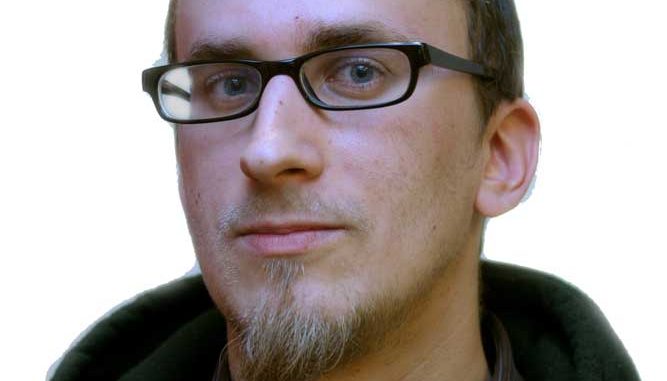
 It’s probably safe to say I live most of my life through the rectangular frame of one screen or another. Whether that rectangle is called a laptop, a desktop, a smartphone, a tablet, a camera, a projector or sometimes even a television, many of my experiences are mediated not only by my senses – go figure – but also by the effects of computer vision.
It’s probably safe to say I live most of my life through the rectangular frame of one screen or another. Whether that rectangle is called a laptop, a desktop, a smartphone, a tablet, a camera, a projector or sometimes even a television, many of my experiences are mediated not only by my senses – go figure – but also by the effects of computer vision.
I wish I didn’t have to choose between making my human body do things in beautiful sunny fields – with puppies – and making not-alive things do alive things behind smudgy sheets of glass. But the idea of running across a field while watching Tarkovsky or Cronenberg films on an iPad just seems ridiculous to me. And, for the love of all that is breathing, I hope that it seems ridiculous to you, too.
Ah, Cronenberg. He made one of my favorite movies, “Videodrome.” Starring James Woods of that one episode of “The Simpsons” fame and Debbie Harry of “Heart of Glass” fame, “Videodrome” is a deeply disturbing sci-fi body horror film from 1983. Woods’ character is a producer for a Canadian soft-core “pr0n” television network looking for something a little edgier.
He discovers the Videodrome broadcast – let’s categorize its content as beyond sado-masochism – but it quickly becomes obvious that the violent hallucinations and body mutations are connected.
It’s probably best if I stop describing the plot of “Videodrome” now, but the main reason I’ve seen it so many times is for the enigmatic wisdom of the film’s wise-yet-weird sage character, Professor Brian O’Blivion. O’Blivion makes it a point to only appear through a television screen – at one point in the film, he is speaking through a television screen as a guest on a talk show, and you’re watching this whole thing through another screen. In his own words, “the television screen is the retina of the mind’s eye” and “whatever appears on the television screen emerges as raw experience for those who watch it.”
So what happens to us who fall asleep with the television on, lulled into a false dreamland by the rapid-fire newspeak of witching-hour televangelists and insurance-loving geckos? No doubt it’s the closest thing to an American dream that we will ever experience.
I have vivid memories of walking the streets of Havertown, Pa., long past my bedtime, my gaze drawn into bedrooms and living rooms by flashing blue lights reflecting off the walls from an unseen source. I could only assume those rooms were inhabited by the ubiquitous glowing rectangles.
When I sometimes inhabited these rooms in my own territory, even my friends comfortably bathed in the glowing emissions of the beloved rectangles. But I was rarely comfortable in these blue rooms – Friday nights became tinged with depression and random angst, painted by the dancing light like a bad acid trip.
Blue glow is obviously a theme here. In my column about jailbreaking iOS, I described a tweak called f.lux that alters the white balance of the device’s screen to match that of the ambient light after sunset. The developers of f.lux, which is also available for Windows, Mac, Android and Linux, justify the need for their tweak with a plethora of research studies proving the detrimental effects of blue light on sleep patterns. And glob knows, we sure have messed-up sleep patterns. My adolescent fears have been validated, to some extent.
Yet still, no matter where I go, I’m drawn to those damned glowing screens. I can be in the middle of a life-changing conversation at El Bar – where many of my life-changing conversations happen – but the flashing and the jumping of the figures on the wall-mounted television never fail to take my eyes off of my life-changing friends. I’d rather my life be changed by a conversation than by pixels understood to represent a football game.
The light itself is only the beginning. While I’ve always been a fan of great films, I never fully realized why so many films in the realist tradition have rejected the traditional psychological acting and plot continuity of Hollywood cinema. But then I signed up for a course in international realist film studies this semester, and I began to make a lot more realizations about the media we consume every day.
One of Hollywood’s most powerful devices is the “suspension of disbelief,” the audience’s deliberate and unquestioning surrender to the world of the film.
Face it: despite how awesome “Star Wars” might be, the dialogue is badly written. But really, the first problem is that it is written, and that Mark Hamill and Carrie Fisher are merely following instructions.
Most cinema is composed of shots, scenes, sequences and sound edited and pulled together in post-production to cover for the fact that it is cinema. Leonardo DiCaprio did not actually sink to the bottom of the Atlantic Ocean. It’s a lie that we blissfully accept as truth because otherwise what’s the point and where’s the fun?
Some cinemas break the traditional rules of film, so as to jar the audience out of complacency. One of the more well-known techniques is the jump cut, a slight change in camera angle that appears less as a different shot from another perspective and more as a leap forward in time. The fragmented nature of cinema is exposed. The audience is breathless.
Remember: you will never see “reality” in a screen. Ever.
Chris Montgomery can be reached at chris.montgomery@temple.edu.


Be the first to comment